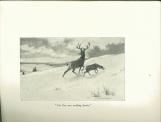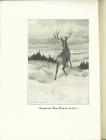1
Trail of the Sandhill Stag proved to be very popular reading for both young people and adults, It followed an earlier publication by Seton, his collection of animals stories, Wild Animals I Have Known, which he published in 1898. Seton published Trail of the Sandhill Stag in 1899, seventeen years after he first spent time in the Carberry Sandhills during his periodic visits to his brother Arthur near Carberry, Manitoba. Reading this story about the protaganist's dogged efforts to track and kill a majestic black tailed stag illustrates how Seton's observations in the area informed his later writings. Not only does he locate the story in the Carberry area, he draws upon his journal nIotes of the 1880's to bring details and notations in to the story. It is fitting that he dedicates the book to the Oldtimers of the Manitoba Plain.In 1882, writing to his friend Jack(Willing) who lived in Toronto Seton makes comments that suggest that he is preparing to publish his work. Seton ponders the costs and feasability of publishing when he says, "Though I fear the great difficulty and expense of reproducing and multiplyng drawings must limit the otherwise profuse illustration. Lithography is I suppose cheap & to a certain exent useable for such places as where one side of a page all the way down is illustration & the other side letterpress."
Seton prepares for a visit to Carberry, Manitoba in March 5, 1892. Writing in his daily journal while attending art school in Paris, France he sets out a taxing expectation of himself for the days he will spend in Carberry. He writes: I do hereby solemnly promise that on my expedition to Manitoba in thesummer of 1892, I will make for each day at least a skin, sketch & a page of journal. The days shall be reckoned from the day of leaving Toronto till the day of return both inclusive, and no days shall be excused on account of weather, saints, travel or anyting but illness. This resolve must have been a necessary ingredient to have made it possible for Seton to complete the innumerous tasks required to accomplish the ambitious career and life goal he set out for himself.
2
Trail of The Sandhill Stag, authored by Ernest Thompson Seton1899
Charles Scribner's Sons, New York, USA
 Credits:
Credits:The Seton Centre, Carberry, Manitoba, Canada
3
Ernest Thompson Seton writes signature with his wolf paw mark1899
Charles Scribner's Sons, New York, USA
 Credits:
Credits:The Seton Centre, Carberrry, Manitoba, Canada
4
Ernest Thompson Seton dedicates his book to the Old-timers of the Big Plain of Manitoba1899
Charles Scribner's Sons, New York, USA
 Credits:
Credits:The Seton Centre, Carberry, Manitoba, Canada
5
Illustration titled:The Trail of a Mother Blacktail was Suddenly joined by two Little Ones' Tracks1899
Charles Scribner's Sons, New York, USA
 Credits:
Credits:The Seton Centre, Carberry, Manitoba, Canada
6
The Trail Spring, an illustration by Seton for his book1899
Charles Scribner's Sons, New York, USA
 Credits:
Credits:The Seton Centre, Carberry, Manitoba, Canada
7
The doe was walking slowly, an illustration for Trail of the Sandhill Stag1899
Charles Scribner's Sons, New York, USA
 Credits:
Credits:The Seton Centre, Carberry, Manitoba, Canada
8
The Stag, which is central to Seton's celebrated story first published in 18991899
Carberry Sandhills, Carberry, Manitoba, Canada
 Credits:
Credits:Charles Scribner's Sons, New York, USA
9
Ernest Thompson Seton's character Yan roams through the Carberry Sandhills1899
Carberry Sandhills, Carberry, Manitoba, Canada
 Credits:
Credits:Charles Scribner's Sons, New York, USA
10
This Illustration Titled: "Scanned the White World for his Foe"1899
Carberry Sandhills, Carberry, Manitoba, Canada
 Credits:
Credits:Charles Scribner's Sons, New York, USA
11
Seven Deer, Their Leader a Wonderful Buck, as illustrated by Ernest Thompson Seton1899
Carberry Sandhills, Carberry, Manitoba, Canada
 Credits:
Credits:Charles Scribner's Sons, New York, USA